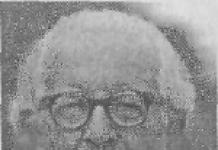Years of life: 1902-1974
Sergei Alekseevich Lebedev is a full member of the USSR Academy of Sciences and the Ukrainian SSR Academy of Sciences, laureate of the Lenin and State Prizes, Hero of Socialist Labor, chief designer of the first electronic computer BESM in the USSR and Europe and a number of other supercomputers. One of the initiators of the formation of the specialty “Computer Engineering” at the Moscow Energy Institute.
Sergei Alekseevich Lebedev was born on November 2, 1902 in Nizhny Novgorod. Mother Anastasia Petrovna (nee Mavrina) left a rich noble estate to become a teacher at an educational institution for girls from poor families. Alexey Ivanovich Lebedev, Sergei's father, worked at a weaving factory.
Education
In 1921, he passed the secondary school exams as an external student. In April 1928, he graduated from the Higher Technical School. Bauman by specialty engineer -electrician. The thesis was devoted to the problems of sustainability of energy systems created according to GOELRO - plan for the electrification of the country. In the course of his work, S.A. Lebedev had to face the need to quickly model complex systems and a large number of labor-intensive calculations.
Labor activity
Then he worked in All-Union Electrotechnical Institute (VEI) . After selection in 1930 Electrical Engineering Faculty of Moscow Higher Technical University into an independent Moscow Energy Institute became a teacher at Moscow Power Engineering Institute. WITH 1936 - professor. At the age of 45, S.A. Lebedev, already a well-known scientist in the field of electrical power, switches completely to a new direction for him - computer technology. At the Institute of Electrical Engineering of the Academy of Sciences of the Ukrainian SSR, he organized the country's first scientific seminar, on the basis of which a laboratory was created for the development of a computer, called MESM (Small Electronic Computing Machine). It became the first computer created in Russia.
In 1951, S.A. Lebedev went to work in Moscow, where he headed a laboratory at the Institute of Precision Mechanics and Computer Technology (ITM and VT) of the USSR Academy of Sciences. From 1953 until the end of his life he was the director of this institute. At ITM and VT, Lebedev led the work on creating several generations of computers. Understanding how important it is to train specialists for a new direction, from 1953 until the end of his days Lebedev headed
Department of Electronic Computers at the Moscow Institute of Physics and Technology.
Sergei Alekseevich Lebedev at ITM and VT led the work on creating several generations of computers.
BESM
In the early 60s, the first computer from the series of large electronic calculating machines (BESM) - BESM-1 - was created. When creating BESM-1, original scientific and design developments were used. This computer was then the most productive machine in Europe (8-10 thousand operations per second) and one of the best in the world.
Under the leadership of S.A. Lebedev, two more tube computers were created and put into production - BESM-2 and M-20. In the 60s, semiconductor versions of the M-20 were created: BESM-3M, BESM-4, M-220 and M-222. When designing BESM-6, the method of preliminary simulation of the operation of the operating system of a future computer was used for the first time, which made it possible to find a number of solutions for organizing the computing process that ensured the longevity of BESM-6, unprecedented in the history of computer technology.
In addition to fundamental developments, S.A. Lebedev performed important work on the creation of multi-machine and multi-processor systems.
The first step in the international recognition of Sergei Alekseevich’s merits in the field of computer science was the awarding of the Computer Pioneer Award medal to him in 1996 for outstanding innovative work in the field of creating computer technology.
Features BESM-6:

- Element base - transistor paraphase amplifier with diode logic at the input
- Clock frequency - 10 MHz
- 48-bit machine word
- Performance - about 1 million operations per second (the most productive American CDC 6600 system, produced since 1964, provided performance of the same order)
- Pipeline central processor (CPU) with separate pipelines for the control unit (CU) and the arithmetic unit (AU). The pipeline made it possible to combine the processing of several commands at different stages of execution.
- 8-layer physical memory organization (interleaving)
- Virtual memory addressing and expandable paging registers.
- Combined control unit for integer and floating arithmetic.
- 16 48-bit word cache: 4 data reads, 4 command reads, 8 write buffer
- The command system included 50 24-bit commands (two per word)
BESM-6 was mass-produced from
1968 to 1987 , a total of 367 cars were produced. In the early 1980s included in delivery Elbrus-1 a 2.5-3 times faster version of BESM-6 was produced, based on integrated circuits -Elbrus-1K2 or SBC(System Reproducing System, unofficial name). As peripheral devices Elbrus components were used. An interface was also introduced into the system EC computer , which made it possible to connect the appropriate peripherals. →In 1928 S.A. Lebedev graduated Moscow Higher Technical School named after. N.E. Bauman (MVTU). His diploma work, completed under the guidance of an outstanding scientist K.A. Circle, was devoted to the problem of stability of parallel operation of power plants and was of great scientific and practical importance. After graduating from the institute, S.A. Lebedev became a teacher at Moscow Higher Technical School and at the same time an employee All-Union Electrotechnical Institute named after. IN AND. Lenin (VEI), first as a junior researcher, group leader, then as head of the Laboratory of Electrical Networks. In 1933, together with A.S. Zhdanov S.A. Lebedev published a monograph " Stability of parallel operation of electrical systems". In 1935, he received the title of professor, in 1939, without being a candidate of science, he defended his doctoral dissertation related to the theory of artificial stability of power systems he developed. For 10 years, S.A. Lebedev headed the automation department of the VEI. In this Many famous scientists began working in the department: D.V. Candlestick, A.V. Mikhailov, A.V Feldbaum, N.N. Sheremetyevsky and etc.
During the war S.A. Lebedev developed a system for stabilizing a tank gun when aiming, which was adopted for service, and an analog system for automatic homing of an aircraft torpedo. In 1945 S.A. Lebedev created the country's first electronic analog computer for solving systems of ordinary differential equations, which are often encountered in problems related to energy.
In 1946 S.A. Lebedev was invited to the Academy of Sciences of Ukraine to the position of director of the Institute of Energy. A year later, the Institute of Energy was divided into two, and S.A. Lebedev became director Institute of Electrical Engineering of the Academy of Sciences of Ukraine.
Here together with L.V. Tsoukernik S.A. Lebedev carried out research on the management of power systems and the development of automation devices that increase the stability of power systems.
In 1950 S.A. Lebedev and L.V. Tsoukernik was awarded the USSR State Prize.
Solving problems in electrical engineering and energy with the help of analog computers, S.A. Lebedev came to the formulation of the problem of creating a digital machine.
Since the fall of 1948 S.A. Lebedev began development (). To determine the set of MESM operations, he invited him to come to Kyiv and K.A. Semendyaeva. Construction Basics MESM were discussed in January-March 1949 at the meeting created by S.A. Lebedev seminar, in which they participated, B.V. Gnedenko, A.Yu. Ishlinsky, A.A. Kharkevich and laboratory staff S.A. Lebedeva.
By the end of 1949, the basic diagram of the machine's blocks was determined. In 1950 MESM was installed in a two-story building of a former monastery in Feofania (near Kiev), where S.A.’s laboratory was located. Lebedeva.

At the end of 1951 MESM passed tests and was accepted into operation by the Commission of the USSR Academy of Sciences, headed by academician. The commission included academicians, professors K.A. Semendyaev, A.G. Kurosh.
In 1952 at MESM the most important scientific and technical problems in the field of thermonuclear processes were solved ( I WOULD. Zeldovich), space flights and rocketry ( M.V. Keldysh, ), long-distance power lines (S.A. Lebedev), mechanics ( G.N. Savin), statistical quality control ( B.V. Gnedenko).
In 1950, when the layout was tested MESM, a similar machine worked only in England - M. Wilks, 1949, and the arithmetic device was sequential.
After MESM the creation of a specialized COMPUTER SESM for solving systems of algebraic equations. Its chief designer was Z.L. Rabinovich. Basic ideas of construction SESM nominated by S.A. Lebedev.
In 1950 S.A. Lebedev began the development of the USSR Academy of Sciences. In March 1950, he was appointed head of the laboratory of the Institute of Precision Mechanics and Computer Science ( ITM and VT), of which he became director M.A. Lavrentiev.

Development of an arithmetic device by S.A. Lebedev instructed P.P. Golovistikov, and control devices - K.S. Neslukhovsky. Internship students from universities also worked on BESM, completing their diploma works - prototyping individual blocks and describing the corresponding sections of the BESM preliminary design: A.G. Louth, I.D. Vizun, A.S. Fedorov And L.A. Orlov. In April 1951, the State Commission, chaired by M.V. Keldysh accepted the preliminary designs of the machines and "".
In the first quarter of 1953, BESM was established, and in April 1953 it was accepted into operation by the State Commission.
Due to the shortage of electronic tubes, which were then supplied only for "", for the first three years it was operated with memory on acoustic mercury tubes, which reduced its performance several times. In 1956, BESM was adopted by the State Commission for the second time - with memory on potentialoscopes.
In 1956 report by S.A. Lebedeva about BESM at an international conference in Darmstadt created a sensation - BESM was on par with the best American machines and the fastest in Europe.
In 1958, BESM with a memory on ferrite cores with a capacity of 2048 words was put into mass production; it was produced under the name plant named after Volodarsky.
In 1953, on the recommendation M.A. Lavrentieva, who became vice-president of the USSR Academy of Sciences, S.A. Lebedev was appointed director. In 1953 he was elected a full member of the USSR Academy of Sciences. At a banquet on the occasion of the election of new members of the Academy S.O. Schmidt said: “Today we elected two wonderful scientists as academicians - S.A. Lebedeva And HELL. Sakharov".
In 1955 S.A. Lebedev began development (the number in the title indicated the expected performance - 20 thousand op./s). No machine in the world had such a computing speed at that time. By decree of the USSR Government, the creation was entrusted to and. S.A. Lebedev became chief designer M.K. Sulim(SKB-245) - his deputy. The ideology and structure of the M-20 was developed by S.A. Lebedev, command system -, circuit design of the element base - P.P. Tadpoles. M.K. Sulim supervised the development of technical documentation and production of a prototype at SKB-245.
In 1958, the State Commission accepted the M-20 and recommended it for mass production.
For the first time in domestic practice in S.A. Lebedev, in order to increase productivity, implemented automatic modification of the address, combining the operation of an arithmetic device and fetching commands from memory, introducing a buffer memory for data arrays printed, combining input and output of data with counting, and the use of fully synchronous signal transmission in logical circuits.

Later, semiconductor versions of the M-20 were developed, implementing the same architecture:
- and (chief designer - M.K. Sulim);
- BESM-3M and (chief designer - O.P. Vasiliev).
ITM and VT after completing work on tubes, he began designing a semiconductor, which had a speed of 1 million op./s. The chief designer of BESM-6 was S.A. Lebedev, his deputies are his students and.
In 1967, the State Commission, chaired by it, accepted it with high praise and recommended it for mass production.
BESM-6 had full software. Many leading programmers of the country took part in its creation.
On the initiative and with the active participation of S.A. Lebedev, during development, modeling of the future machine was carried out using software models.
Based on BESM-6, collective computing centers for scientific organizations, automation systems for scientific research in nuclear physics and other fields of science, and information and computing systems for real-time information processing were created. It was used to simulate complex physical and control processes in software design systems for new computers.

BESM-6 was produced for 17 years. For the development and implementation of BESM-6 its creators (from ITM and VT - S.A. Lebedev, V.A. Melnikov, L.N. Korolev, L.A. Zak, V.N. Laut, V.I. Smirnov , A.A. Sokolov, A.N. Tomilin, M.V. Tyapkin, from the SAM plant - V.A. Ivanov, V.Ya. Semeshkin) were awarded the State Prize.
ITM and VT, together with the SAM plant, based on BESM-6, developed a computing system, the modular organization and unified exchange channels of which provided the ability to build decentralized multi-machine computing systems. The efficient implementation of translators from high-level programming languages and a multi-level memory protection system based on state stack mechanisms were provided. , built on the principle of decentralization, ensured operation in batch processing, remote batch processing, time sharing, and real time modes. AS-6 was used for data processing and control in space experiment systems, as well as in a number of computer centers of large research organizations.
Specialized computers created under the leadership of S.A. Lebedev for the missile defense system, became the basis for achieving strategic parity between the USSR and the USA during the Cold War. In 1952-1955. student S.A. Lebedev were developed specialized for automatic data collection from radar and automatic target tracking. Then for the missile defense system, the general designer of which was G.V. Kisunko, in 1958 the M-40 tube computer was proposed, and a little later the M-50 (floating point).
The ability to destroy ballistic missiles provided by missile defense forced the United States to look for ways to conclude an agreement with the USSR on limiting missile defense, which appeared in 1972.
The creators of the first missile defense system received the Lenin Prize. Among them were G.V. Kisunko, S.A. Lebedev and V.S. Burtsev.
See the release of the next series of high-performance computers developed by ITM and VT, S.A. Lebedev did not have the chance.
Sergei Alekseevich Lebedev died on July 3, 1974 in Moscow. He is buried at the Novodevichy cemetery.
Name S.A. Lebedeva now wears ITM and VT. Students of S.A. Lebedev created their own scientific schools and teams.
Academician Sergei Alekseevich Lebedev (1902−1974) is an outstanding electrical engineer, power engineer and founder of domestic computer technology.
Sergei Alekseevich devoted the first half of his life to the problems of electric power and automation, and the second to the creation of electronic digital computer technology. And everywhere he was accompanied by enormous scientific success, which entailed recognition of his merits not only in our country, but also abroad.
Sergei Alekseevich was born on November 2, 1902 in Nizhny Novgorod in the family of writer Alexei Ivanovich Lebedev and Anastasia Petrovna Mavrina. Since childhood, the future scientist was interested in technology, photography, and loved music, fine arts, and theater.
Years of study at the Moscow Higher Technical School named after. N.E. Bauman (MVTU), then the Institute of Mechanics and Mathematics, were for Sergei Alekseevich a time of not only intensive studies, but also the first scientific research.
After graduating from the institute in 1928, S.A. Lebedev becomes a teacher at Moscow Higher Technical School named after. N.E. Bauman and a junior researcher at the All-Union Electrotechnical Institute (VEI), where he worked until 1946. At VEI, Sergei Alekseevich worked on problems of stability and regulation of energy systems. During these same years, his abilities as a leader and organizer of science emerged.
In 1935 S.A. Lebedev received the title of professor; in 1939, without being a candidate of science, he defended his doctoral dissertation related to the theory of artificial stability of power systems he developed. For 10 years he headed the automation department of VEI. During the war, Sergei Alekseevich completely switched to defense topics.
In 1945, under the leadership of the scientist, one of the first electronic analog computers in the country was created to solve systems of ordinary differential equations, which are often encountered in problems related to energy.
In 1946 S.A. Lebedev was invited to the Ukrainian Academy of Sciences to serve as director of the Institute of Energy. A year later, the Institute of Energy was divided into two, and S.A. Lebedev became director of the Institute of Electrical Engineering of the Academy of Sciences of Ukraine. Here, together with L.V. Tsoukernik Lebedev carried out research on the management of power systems and the development of automation devices that increase the stability of power systems. In 1950 they were awarded the USSR State Prize.
Solving problems in electrical engineering and energy with the help of analog computers, S.A. Lebedev came to the formulation of the problem of creating a digital machine.
In 1946, at the Institute of Electrical Engineering of the Academy of Sciences of Ukraine, Sergei Alekseevich headed research in the field of computer technology, the result of which was the creation of the first domestic computer - a small electronic calculating machine (MESM).
At the beginning of 1957, S.A. Lebedev writes: “...In 1948−1949. I developed the basic principles for constructing electronic calculating machines. Considering their exceptional importance for our national economy, as well as the lack of any experience in their construction and operation in the Union, I decided to create a small electronic calculating machine as quickly as possible, on which it would be possible to study the basic principles of construction and test the methodology for solving individual problems and gain operational experience..."
The minutes of the Academic Council of the Institute of Electrical Engineering and Thermal Power Engineering of the Academy of Sciences of Ukraine noted “According to foreign literature, the design and construction of the machine takes 5-10 years, we want to build the machine in 2 years.”
In the book “How It Began” the main assistants of S.A. Lebedeva L.N. Dashevsky and E.A. Shkabar is recalled: “... At the end of 1951, a very representative commission of the USSR Academy of Sciences arrived in Feofania from Moscow to accept MESM into operation. This commission was headed by Academician M.V. Keldysh. I took the MESM exams for three days. And although the exams were not competitive, since she had no competitors, everyone was terribly worried. Academicians with inscrutable faces walked from the MESM premises, where they asked her all sorts of “tricky problems”, to Sergei Alekseevich’s office and conferred there for a long time. And our MESM came out into the people. The rejoicing was universal. Finally, the tests were completed, and the commission decided: to accept the vehicle into operation on December 25, 1951.”
25 years after the creation of the first universal computer in our country, the documentary film “Keep Forever” was shot, which included unique footage of the operation of this machine. Only a few minutes on the screen MESM counts (executes the program), but these frames make a very strong impression and are remembered forever.
After MESM, the creation of a specialized computer SESM began for solving systems of linear algebraic equations. The main ideas for constructing an SEMS were put forward by S.A. Lebedev.
In 1950 S.A. Lebedev began developing BESM (High-Speed Electronic Computing Machine). In March 1950, he was appointed head of the laboratory of the Institute of Precision Mechanics and Computer Technology (ITMiVT), whose director was Academician M.A. Lavrentyev. In the first quarter of 1953, BESM was established, and in April 1953 it was accepted into operation by the State Commission. Due to the shortage of cathode ray tubes, which were then supplied only for the Strela digital computer, for the first three years the BESM was operated with a memory based on acoustic mercury tubes, which reduced its performance several times. In 1956, BESM was adopted by the State Commission for the second time - with memory on potentialoscopes.
In 1956, a report by S.A. Lebedev's announcement of BESM at an international conference in Darmstadt created a sensation - BESM was on par with the best American machines and the fastest in Europe.
In 1953, Sergei Alekseevich was elected a full member of the USSR Academy of Sciences. At the banquet dedicated to the election of new members of the Academy S.O. Schmidt said: “Today we elected two wonderful scientists as academicians - S.A. Lebedev and A.D. Sakharov.”
In 1955 S.A. Lebedev began developing the M-20 (the number in the name indicated the expected performance - 20 thousand op./s). No machine in the world had such a computing speed at that time. In 1958, the State Commission accepted the M-20 and recommended it for mass production. For the first time in domestic practice in M-20 S.A. Lebedev, in order to increase productivity, implemented the combination of the operation of an arithmetic device and fetching commands from memory, the introduction of buffer memory for data arrays printed, the combination of data input and output with counting, etc. Later, semiconductor versions of the M-20 were developed, implementing the same architecture: - M-220 and M-222.
In April 1959, a delegation of Soviet computer specialists, headed by Academician S.A. Lebedev, visited the United States of America, in particular, IBM, the Massachusetts Institute of Technology, Harvard, Philadelphia, Washington, and the National Bureau of Standards in New York. And everywhere they were warmly greeted by representatives of universities and the largest companies in America. The obstacles caused by the Cold War did not prevent scientists from the two countries from communicating fruitfully, exchanging their accumulated experience in the field of creating computer technology and discussing all the problems that arose.
Under the leadership of S.A. Lebedev ITMiVT, after completing work on the tube BESM-2 and M-20, began designing the semiconductor BESM-6, which had a speed of 1 million op./s. The State Commission chaired by M.V. Keldysh received BESM-6 with high praise and recommended it for mass production. BESM-6 had full software. Many leading programmers of the country took part in its creation.
Based on BESM-6, collective computing centers for scientific organizations, automation systems for scientific research in nuclear physics and other fields of science, and information and computing systems for real-time information processing were created. It was used to simulate complex physical and control processes in software design systems for new computers. BESM-6 was produced by the Moscow SAM plant for 17 years.
For the development and implementation of BESM-6 its creators (from ITMiVT - S.A. Lebedev, V.A. Melnikov, L.N. Korolev, L.A. Zak, V.N. Laut, V.I. Smirnov, A A. Sokolov, A. N. Tomilin, M. V. Tyapkin, from the SAM plant - V. A. Ivanov, V. Ya. Semeshkin) were awarded the State Prize.
ITMiVT, together with the SAM plant, based on BESM-6, developed the AS-6 computing system, the modular organization and unified exchange channels of which provided the ability to build decentralized multi-machine computing systems. The AC-6 operating system provided operation in batch processing, remote batch processing, time sharing, and real time modes. AS-6 was used for data processing and control in space experiment systems, as well as in a number of computer centers of large research organizations.
For 20 years, Sergei Alekseevich headed the many-thousand-strong team of the Institute of Precision Mechanics and Computer Technology (ITMICT) of the USSR Academy of Sciences.
Specialized computers created under the leadership of S.A. Lebedev for the missile defense system, became the basis for achieving strategic parity between the USSR and the USA during the Cold War. In 1952−1955 student S.A. Lebedeva V.S. Burtsev developed specialized computers "Diana-1" and "Diana-2" for automatically retrieving data from the radar and automatically tracking targets. Then for the missile defense system (BMD), the general designer of which was G.V. Kisunko, in 1958 the M-40 tube computer was proposed, and a little later the M-50. The creators of the first missile defense system received the Lenin Prize. Among them were G.V. Kisunko, S.A. Lebedev and V.S. Burtsev. See the release of the next series of high-performance computers developed by ITMiVT, S.A. Lebedev did not have the chance. Sergei Alekseevich Lebedev died on July 3, 1974 in Moscow. He is buried at the Novodevichy cemetery.
Sergei Alekseevich Lebedev, a talented scientist and organizer, is rightfully considered the founder of domestic computer technology. Name S.A. Lebedeva now wears ITMIVT, which has a small museum. Students of S.A. Lebedev created their own scientific schools and teams.
The world scientific community recognized the merits of S.A. Lebedev in 1996, awarding him the title “Pioneer of Computer Engineering.”
“... He lived and worked during a period of rapid development of electronics, computer technology, rocket science, space exploration and atomic energy. Being a patriot of his country, Sergei Alekseevich took part in the largest projects of I.V. Kurchatova, S.P. Koroleva, V.M. Keldysh, who ensured the creation of the shield of the Motherland. In all their works, the role of electronic computers created by Sergei Alekseevich, without exaggeration, is enormous. His outstanding works will forever be included in the treasury of world science and technology, and his name should stand next to the names of these great scientists,” Academician B.E. wrote about him. Paton.
Prepared by:
Smolevitskaya M.E. – Pioneer of domestic computer engineering Sergei Alekseevich Lebedev (1902−1974) // Problems of cultural heritage in the field of engineering: collection of articles. – Issue 4. – M., 2003. – P.64−89.
On November 2, 1902, Lebedev S.A. was born in Nizhny Novgorod. - an outstanding scientist who was destined to become the creator of domestic computers.
Moreover, Lebedev’s developments in this area were not inferior to their Western counterparts, and even ahead of them. But for a long time the name of the scientist was known only to a narrow circle of specialists.
However, the times of the Cold War deprived many scientists and designers whose work was of defense significance from the well-deserved wide fame.
Due to the secrecy, a myth was born that the USSR, and then Russia, were far behind in the creation and development of computer technology. In reality, everything is not so simple here. And if you look at the facts, it turns out that not only in the “field of ballet,” but also in the creation of computers, we were “ahead of the rest.” Here are Lebedev's works.
In 1945, it was he who created the country's first electronic computer. His employees are confident that if not for the war, during which he, an electrical engineer, was engaged in the automation of military equipment, work on creating a computer using a binary number system (different from the decimal number system that we use in everyday life) would have begun and ended much earlier.
In 1948-1949, he made a fundamental contribution to domestic digital computing technology - independently and in parallel with Western scientists, he developed the principles of constructing a computer with a program stored in memory and implemented them with the team of his laboratory in the Small Electronic Computing Machine.
By the end of 1949, the general layout of the machine and the schematic diagrams of its blocks were developed. In the first half of 1950, individual blocks were manufactured and debugging began in their interconnection; by the end of 1950, debugging of the created layout was completed. On January 4, 1952, the Presidium of the USSR Academy of Sciences heard Lebedev’s report on the commissioning of the small electronic digital calculating machine MESM .
In 1952, MESM was practically the only computer in the country that solved the most important scientific and technical problems in the field of thermonuclear processes, space flight and rocketry, long-distance power lines, mechanics, statistical quality control, etc.
Best of the day
Independently of foreign scientists, S.A. Lebedev developed the principles of constructing a computer with a program stored in memory. Under his leadership, the first computer in continental Europe was created, important scientific and technical problems were solved in a short time, which marked the beginning of the Soviet school of programming. The description of MESM became the first textbook on computer technology in the country. MESM was the prototype of the BESM Large Electronic Calculating Machine.
Among the world's scientists, Lebedev's contemporaries, there is no person who, like him, would have such a powerful creative potential to cover in his scientific activity the period from the creation of the first tube computers, performing only hundreds and thousands of operations per second, to ultra-high-speed super-computers on semiconductors, and then on integrated circuits with performance up to millions of operations per second. Lebedev's scientific school, which became the leading one in the former USSR, successfully competed with the famous American company IBM in its results. Under his leadership, 15 types of high-performance, most complex computers were created and transferred for serial production, each a new word in computer technology, more productive, more reliable and easy to use.
S.A. Lebedev combined two remarkable qualities that distinguished him from everyone else - outstanding abilities and exceptional modesty. This was the impression given to all the people who knew him well.
Lebedev’s students L.N. Korolev and V.A. Melnikov, who became prominent scientists, wrote in one of their works: “Lebedev’s genius lay precisely in the fact that he set a goal taking into account the development of the structure of the future machine, and knew how to choose the right means for its implementation in relation to the capabilities of domestic industry."
The words of the epigraph “Being able to give direction is a sign of genius” are quite applicable to the person who laid the foundation for domestic computer engineering. The scientist took upon himself the most important and difficult thing in the new field of technology - the creation of a super-computer - the most complex class of computer technology. Moreover, here, too, he immediately and unmistakably chose the main direction of development of digital computers of this class - parallelization of the computing process. It still remains the main thing in the development of supercomputers.
The assessments expressed above appeared only after the death of S.A. Lebedev. During his lifetime, newspapers and magazines did not write about him. There were two reasons for this. One is official: his name as the chief designer of computers for missile defense systems was classified. The second stemmed from his character traits: he could talk a lot about the open, main part of his work on creating super-computers for computer centers, about his institute and much more, but he did not like to meet with journalists, was extremely alien to self-promotion and absolutely indifferent to fame and glory. Opening the First All-Union Conference on Computer Science in 1956 in Moscow and characterizing the level of development of computer technology in the USSR, he did not even mention MESM, which, as is now obvious, became the first computer in continental Europe. For him, it was just a computer model, creating which he gained experience for subsequent work.
His performance was amazing. During the years of computer creation, he, fortifying himself with the strongest tea and Kazbek cigarettes, often worked for many days, with virtually no rest. This “charged” and inspired the people who worked with him. “We worked until exhaustion,” recalls former student intern L. Ivanenko. “Somewhere at midnight, Sergei Alekseevich sent the young people to bed and said that he himself would still sit at the oscilloscope. In the morning they found him in the same place. He kept peering at the chimeric bursts blue curves on the screen..."
As a person, he attracted people with his high spirituality, desire not to stand out among others, his never-failing sense of humor, optimism in life and other wonderful qualities.
As a scientist, he attracted people with his obsession in trying to achieve his goal, his deep penetration into the new field of science and technology he had begun, and his diverse engineering experience, which allowed him to use many thousands of electronic tubes to realize his plan at a time when their number in the most complex devices did not exceed two dozen!
In the history of science of the twentieth century, there is no other scientist like Sergei Lebedev, whose active creative life covered the entire period of the creation of electronic technology - from the first vacuum tube computers to supercomputers on integrated circuits.
Under his leadership, 15 types of machines were created, each of which was a new word in this field. Lebedev's machines were the fastest in Europe, and in some of their structural features they were superior to the products of American companies. And today Russia holds the lead in the speed of computing systems among European countries, ranking third in the world in this indicator. The Interdepartmental Supercomputing Center in Moscow operates a system of 768 processors with a speed of 1 teraflop - a trillion operations per second. Lebedev’s contribution to the creation of nuclear energy and the country’s nuclear shield can hardly be overestimated. He has worked in other defense areas as well. Using computer systems developed under his leadership, a missile defense system was first created, which in 1961 shot down a ballistic missile. In the USA, such a “trick” was repeated more than 20 years later. Shortly before his death in 1974, Academician Lebedev approved the task of developing the Elbrus computer complex.


















